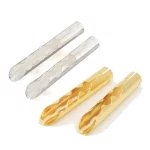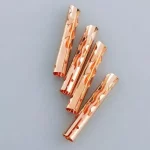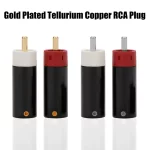Oh , I did buy $5k worth of Audio Note silver (25% of retail cost ) and it did what it supposed to do, when I could still hear the turn signal alert in the car 🙂
I get it that people just don't care, that's fine, it can still be a awesome hobby. But all this talk of "I can't measure it on my scope, so it doesn't exist"....
Everybody using this site cares.I get it that people just don't care
I don't care to spend my limited resources on dubious products though.
That is a good piece I've seen before -- http://www.roger-russell.com/wire/wire.htm#differences
Fun excerpt:
I had stints working in high end audio retail in the 70s and 80s, drank the Cool-aid and sold/used dedicated pricey speaker cables. You would not believe the incredible margins on most of them. Adding pricey special speaker cable was a sure fire way to claw back margin you gave away on other components in a system to a bargain hunter. Similar to upselling to a $100 Shibata house-brand cartridge made by Audio Technica that cost the store $13 instead of the $50 retail elliptical stylus cartridge that cost $9. 🙄😆
CAT6 direct burial cable is what I've often used for wiring up drivers inside speakers to the jack that connects to the wire run between amp and speaker. I had lots -- left over from 1000' I used to wire a couple outbuildings on my property for internet/networking. Still have lots.
Before I used it, I examined the cable & scraped at the wire. It is all copper, 23 gauge, robust. I figured it was worth trying.
Wired up one speaker with that, the other with 14g cable from the last batch of Audioquest speaker cable -- long discontinued, I am sure. Used 2 strands per driver terminal; 4 for each driver. Woofers I doubled up on. (4x2) Left the twisted pairs; no point trying to unravel those.
Could not hear any difference, and nothing I could measure showed any difference at all.
They were pretty high performance speakers, run on high quality electronics & source material.
I have also used them for speaker runs in my "lab/studio" where lots of trials & experiments are done & I'm always short of speaker cables. 4x2 for each terminal. It's a bit stiff and the bared ends can break with repeated use. But it is good enough for the application.
My take on speaker cables today is like that of many celebrated speaker gurus: Just ensure it meets basic parameters for resistance, capacitance, inductance, insulation. Other aspects don't matter, whatever effects there might be, they are all way beyond human hearing range, and any genuine audible differences can be traced to odd interface issues between components. So many other factors matter so much more, there's no point -- ie, a half dB imbalance in left and right mid drivers or momentary clipping from an amp trying to drive a speaker whose impedance drops too low at key frequencies -- these are audible issues that matter.
Fun excerpt:
"In several A-B a listening tests using music, a comparison to Monster cable showed that it was not possible to determine which was connected and which sounded best."
I had stints working in high end audio retail in the 70s and 80s, drank the Cool-aid and sold/used dedicated pricey speaker cables. You would not believe the incredible margins on most of them. Adding pricey special speaker cable was a sure fire way to claw back margin you gave away on other components in a system to a bargain hunter. Similar to upselling to a $100 Shibata house-brand cartridge made by Audio Technica that cost the store $13 instead of the $50 retail elliptical stylus cartridge that cost $9. 🙄😆
CAT6 direct burial cable is what I've often used for wiring up drivers inside speakers to the jack that connects to the wire run between amp and speaker. I had lots -- left over from 1000' I used to wire a couple outbuildings on my property for internet/networking. Still have lots.
Before I used it, I examined the cable & scraped at the wire. It is all copper, 23 gauge, robust. I figured it was worth trying.
Wired up one speaker with that, the other with 14g cable from the last batch of Audioquest speaker cable -- long discontinued, I am sure. Used 2 strands per driver terminal; 4 for each driver. Woofers I doubled up on. (4x2) Left the twisted pairs; no point trying to unravel those.
Could not hear any difference, and nothing I could measure showed any difference at all.
They were pretty high performance speakers, run on high quality electronics & source material.
I have also used them for speaker runs in my "lab/studio" where lots of trials & experiments are done & I'm always short of speaker cables. 4x2 for each terminal. It's a bit stiff and the bared ends can break with repeated use. But it is good enough for the application.
My take on speaker cables today is like that of many celebrated speaker gurus: Just ensure it meets basic parameters for resistance, capacitance, inductance, insulation. Other aspects don't matter, whatever effects there might be, they are all way beyond human hearing range, and any genuine audible differences can be traced to odd interface issues between components. So many other factors matter so much more, there's no point -- ie, a half dB imbalance in left and right mid drivers or momentary clipping from an amp trying to drive a speaker whose impedance drops too low at key frequencies -- these are audible issues that matter.
Anything with bare copper wire will require higher-quality terminals (binding posts). Since copper oxidizes, you need something that can both create a gas-tight connection, and bite through any existing oxides that might remain after whatever cleaning procedure one might perform.
Bananas get away with a lot since you can't really mess up a gold-to-gold connection as long as there's even a mild contact force.
Bananas get away with a lot since you can't really mess up a gold-to-gold connection as long as there's even a mild contact force.
The definitive test of speaker cables is AbsoluteListening Tests-Further Progress
It's really quite obvious. Compare what goes in, with what comes out, when connected to real loudspeakers
You can also measure the change in response, THD bla bla etc but the original aim was to listen to the differences.
Some 'highly regarded Audiophile cables' came out badly ... especially the braided ones. Monster Cable of that period was the best of the commercial stuff.
But BY FAR THE BEST both in the DBLTs and measurements, was Lightning Conductor stripped from Churches in the Yorkshire Dales. We used British Sellotape for insulation. Dunno if foreign Scotch Tape would be as good.
Loadsa work to enable sensible connection between the Lightning Conductor and your amp & speaker terminals without introducing lesser conduits of musicality 😊
It's really quite obvious. Compare what goes in, with what comes out, when connected to real loudspeakers
You can also measure the change in response, THD bla bla etc but the original aim was to listen to the differences.
Some 'highly regarded Audiophile cables' came out badly ... especially the braided ones. Monster Cable of that period was the best of the commercial stuff.
But BY FAR THE BEST both in the DBLTs and measurements, was Lightning Conductor stripped from Churches in the Yorkshire Dales. We used British Sellotape for insulation. Dunno if foreign Scotch Tape would be as good.
Loadsa work to enable sensible connection between the Lightning Conductor and your amp & speaker terminals without introducing lesser conduits of musicality 😊
You seem to understand the business 🙂 As a seller.Just buy the most expensive wire you can find.
That will sound the best.
Both of these statements are exaggerated to the point they have lost their meaning.Dr. Geddes ignores amplifiers saying that they all sound the same and receiver quality is all what's needed. And what are you going to say to that? He also says that you can pretty much ignore any LF turning and complicated modeling of LF response in speakers because room is going to **** it up anyway
I made speaker cables and interconnects from CAT5 a long time ago, as well as some other wires, thinner and thicker, both multistrand and solid core. I also tried super thin wires according to the Allen Wright Cables Cookbook. I was not impressed with any of these, and ended up with VDH CS122 and VDH D102MK3 for a long time. I made 230VAC cables from VDH CS12.
Every now and then someone brings me an expensive cable to test. There are better and worse ones than mine, but I won't be changing them anytime soon. Instead of banana plugs, I used those 4mm hollow plugs. For interconnects I take these plastic RCA plugs.
I experimented a bit, tried various things, and when I came to an acceptable solution, I stopped there. I'm not a cable maniac, just for the record. 🤣
Every now and then someone brings me an expensive cable to test. There are better and worse ones than mine, but I won't be changing them anytime soon. Instead of banana plugs, I used those 4mm hollow plugs. For interconnects I take these plastic RCA plugs.
I experimented a bit, tried various things, and when I came to an acceptable solution, I stopped there. I'm not a cable maniac, just for the record. 🤣
Attachments
Last edited:
I worked a lot on cable, you have skin effect of the current, higher is the frequency, the current circulates in a small layer of the copper.I've used regular old romex found in walls and its pretty good up to 14 awg. Thicker than that it loses its punch in the lower mids, likely due to higher insertion resistance. I have consistently found that solid wire beats stranded, but litz wire is superior to any type of conductor orientation. It does however depend on the weave pattern.
I calculated 20kHz, the thick of this layer is 0.5mm, all cable above 24 awg will have skin effect, a variable resistance depends on the frequency.
The compromise is complex to avoid skin effect and have awg to supply current 🙂 And you are not taking account the dielectric, the characteristics of the insulation. Litz cable has a very good architecture 😉
Yes cable is no so simple, it is not only metal and plastic ... See the Telegrapher's equations and Skin effect
Last edited:
I get it that people just don't care, that's fine, it can still be a awesome hobby. But all this talk of "I can't measure it on my scope, so it doesn't exist"....
I think it may be more a distinction between people that hear something unexpected as we all do and then lean towards it being for reasons unknown to science or lean towards something being a bit off and investigating what it might be. It is hard to see anything particularly wrong with magical thinking and/or avoiding effort when it comes to a hobby but it is inevitably going to be a source of friction with people that reason differently.
I only use silver plated copper wires and gold or silver plated connectors. There is never a problem with the oxide layer. Occasionally you may clean all the connectors with isopropyl alcohol. Let's say once a year spend 15 minutes on cleaning.
These discussions seems to be repeated over and over again, and often ends up with "the party of believers" against the "doubters". I remember the time when all connectors had to be cleaned with alcohol before every listening... To many factors may be influenced by cables to say that the effect is nil. To get a grip on what will work in general, a reality check is helpful. Skin effect is real at high freq => use multi-strand wires where each strand is thin. Also known is that a crimped connection is better than a soldered, a welded is even better.... Don't forget to listen to the music instead of trying to dissect it.
Sometimes the difference heard can be real, but not necessarily recognised by others. For example, if you change cables there's the chance you'll upset a layer of corrosion which has developed since you twisted the ends with your fingers.. or maybe galvanic corrosion.
Such a difference would be clear in measurements plus I am pretty sure most people know to check connections even the less technical. People that lean towards magical thinking may well be aware of possible connection issues but the attraction of the difference being due to exotic cables rather than mudane maintenance issues seems to inhibit rational thought. The degree of inhibition can also vary with subject. An example I came across was a pharmacist who was also an audiophile. He had a rational understanding of homeopathy but was away with the fairies when it came to home audio. In contrast others seem to widely adopt magical thinking. It's an interesting subject but a tricky one to keep the discussion from deteriorating.
I believe much of the audible improvements we can detect simply has to do with "cleaning up" bad connections that have already knowingly existed.
Some types of wire construction are more prone to inter-conductor deterioration than others. This also isnt linear, making the improvements through replacement not as consistently detectable.
Litz tyoe wire construction is the most reliable for wider bandwidth applications. This is why its used exclusively for HF and isn't as prone to breakdown inside the cunductor core. This will make the best long term connection reliability in more demanding applications.
The conductive material inside the wire itself isn't as detectable unless it significantly alters the frequency response.
Materials like silver need to be litz or solid core construction, as its prone to tarnishing very quickly. If the wire is used in a high vibration application, it will be very microphonic.
Some types of wire construction are more prone to inter-conductor deterioration than others. This also isnt linear, making the improvements through replacement not as consistently detectable.
Litz tyoe wire construction is the most reliable for wider bandwidth applications. This is why its used exclusively for HF and isn't as prone to breakdown inside the cunductor core. This will make the best long term connection reliability in more demanding applications.
The conductive material inside the wire itself isn't as detectable unless it significantly alters the frequency response.
Materials like silver need to be litz or solid core construction, as its prone to tarnishing very quickly. If the wire is used in a high vibration application, it will be very microphonic.
It doesn't exactly work on cue. I'd guess most find out about it by accident.Such a difference would be clear in measurements plus I am pretty sure most people know to check connections even the less technical.
- Home
- Loudspeakers
- Multi-Way
- CAT5/6 as a budget high performance speaker cable option


